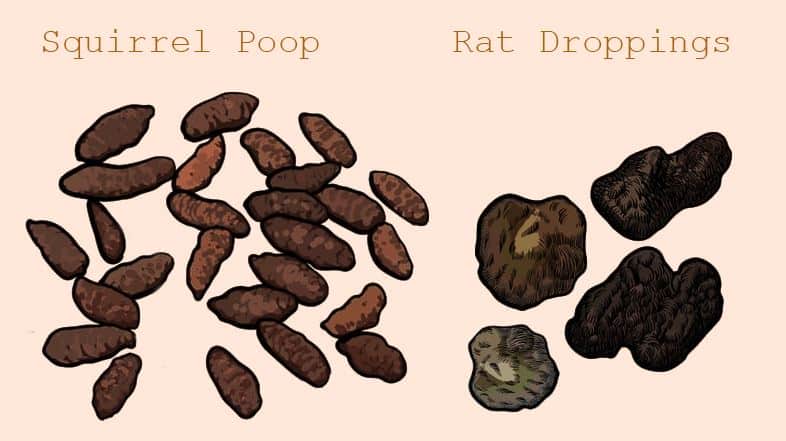Squirrel Poop and Rat Poop: What are the differences?
When you think about the difference between squirrel poop and rat droppings, it’s not the ideal pass time. Regardless, if you’ve noticed animal droppings in your home, you are best off being able to identify what type of feces is present. It would be best if you distinguished between rat droppings and squirrel droppings.
When considering distinctions between these droppings, there are some definite physical differences. There are also differences in what kinds of bacteria or viruses potentially can be carried in these two different types of feces. Both categories of variations are discussed in this article.

squirrel poop looks different than rat poop
Squirrel Poop Color
With only a glance at squirrel and rat droppings, you might initially determine that they look quite similar. When looking closely, you will be able to tell the difference in color and texture between rat and squirrel droppings.
Overall, squirrel feces tend to be paler than are those of rats, and rat droppings usually are darker, almost black. This difference is chalked up to the diets of these two different animals. Rats have a much more diverse menu. Some say all eat nearly anything. Squirrel droppings are usually brownish or even have a bit of a red hue.
Related article: Identifying Squirrel Poop
Shape of Squirrel Poop
The shape of excretions is another way of identifying between squirrel and rat droppings. A squirrel’s wastes usually are more significant than those of a rat. Besides, a squirrel discharges wastes that are extra barrel-shaped. Squirrel feces approximately always see even, level on the surface.
On the other hand, rat feces remain oblong. Indeed, they can seem almost rectangular, absent, genuinely excellent edges. Rat feces additionally tend to be smooth, but seldom not as even as those discharged by squirrels.
At first glance, the feces of those two animals are sometimes referred to as seeing like raisins. This recommendation is made to outline and size, but not surface texture.
Edges
The contour of the advantages is another way that you can identify that squirrel and rat droppings apart. Rat droppings usually are thicker in the middle and pointy on each side. Also, squirrel droppings always have what softer and more circular periods is.
Related article: What Does Squirrel Poop Look Like?
Squirrel Dropping Distribution
Squirrel feces tend to be grouped in unique spots. Squirrels can be sneaky when it comes to where they relieve themselves. They usually don’t scatter their feces.
The same cannot be said of rats. Rats are primarily indiscriminate and expel feces relatively indiscriminately. With that said, rat feces will be mainly spread out along the paths they take to get from one spot to the next.
Volume of Squirrel Droppings
There is one common element with both rat and squirrel feces. This holds for all critters. Both rats and squirrels pass a considerable amount of wastes daily.

squirrel poop in attic
Diseases Contracted From Squirrel Feces
Squirrels and humans coexist reasonably quickly. Humans and squirrels do not often come into conflict with one another.
Some diseases can be carried in squirrel waste.
The passing of disease from squirrel feces to humans is not common, but there are a plethora of conditions that potentially can be transferred from squirrel feces to humans like these, for example.:
- Salmonella
- Tularemia
- Leptospirosis
- Diseases Contracted From Rat Feces
Rat feces can also carry salmonella. Furthermore, rat droppings can also give the hantavirus, a virus that was initially recognized in the United States in 1993. During the first ten years following the finding of hantavirus in the Four Corners area of the country, more than 1000 individuals were infected with the virus. More than 200 people died.
Related article: Is Squirrel Poop Dangerous?
Dust From Squirrel and Rat Droppings
When rat and squirrel droppings lose their moisture, they can crumble, releasing dust into the air.
With that said, when feces crumble, and the associated dust becomes airborne, the powder sometimes contained harmful pathogens, such as leptospirosis in either animal and hantavirus in rats. If the powder containing pathogens is inhaled, the individual may become infected. Death can occur in over 30 percent of germs with the hantavirus.
This necessity of exercising care when cleaning up either dropping. The odds are that you will be more likely to face the rat droppings as opposed to squirrel droppings. There are wildlife removal professionals trained in safely and thoroughly cleaning up potentially contaminated materials, including squirrel droppings and rat droppings.

